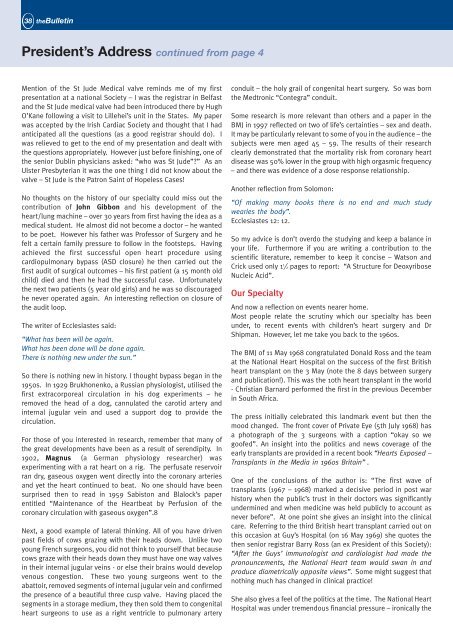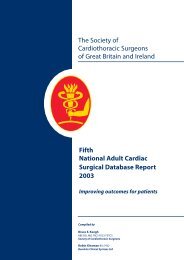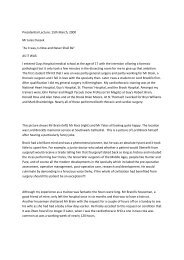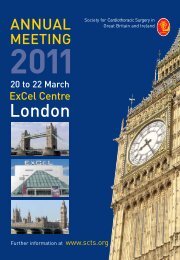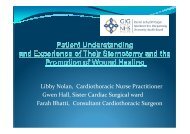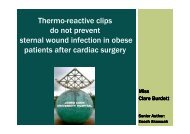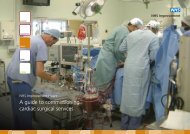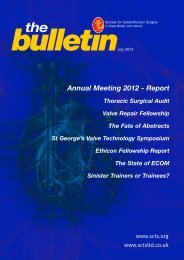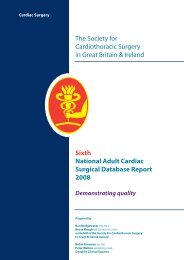Download - Society for Cardiothoracic Surgery
Download - Society for Cardiothoracic Surgery
Download - Society for Cardiothoracic Surgery
Create successful ePaper yourself
Turn your PDF publications into a flip-book with our unique Google optimized e-Paper software.
38 theBulletin<br />
President’s Address continued from page 4<br />
Mention of the St Jude Medical valve reminds me of my first<br />
presentation at a national <strong>Society</strong> – I was the registrar in Belfast<br />
and the St Jude medical valve had been introduced there by Hugh<br />
O’Kane following a visit to Lillehei’s unit in the States. My paper<br />
was accepted by the Irish Cardiac <strong>Society</strong> and thought that I had<br />
anticipated all the questions (as a good registrar should do). I<br />
was relieved to get to the end of my presentation and dealt with<br />
the questions appropriately. However just be<strong>for</strong>e finishing, one of<br />
the senior Dublin physicians asked: “who was St Jude”?” As an<br />
Ulster Presbyterian it was the one thing I did not know about the<br />
valve – St Jude is the Patron Saint of Hopeless Cases!<br />
No thoughts on the history of our specialty could miss out the<br />
contribution of John Gibbon and his development of the<br />
heart/lung machine – over 30 years from first having the idea as a<br />
medical student. He almost did not become a doctor – he wanted<br />
to be poet. However his father was Professor of <strong>Surgery</strong> and he<br />
felt a certain family pressure to follow in the footsteps. Having<br />
achieved the first successful open heart procedure using<br />
cardiopulmonary bypass (ASD closure) he then carried out the<br />
first audit of surgical outcomes – his first patient (a 15 month old<br />
child) died and then he had the successful case. Un<strong>for</strong>tunately<br />
the next two patients (5 year old girls) and he was so discouraged<br />
he never operated again. An interesting reflection on closure of<br />
the audit loop.<br />
The writer of Ecclesiastes said:<br />
“What has been will be again.<br />
What has been done will be done again.<br />
There is nothing new under the sun.”<br />
So there is nothing new in history. I thought bypass began in the<br />
1950s. In 1929 Brukhonenko, a Russian physiologist, utilised the<br />
first extracorporeal circulation in his dog experiments – he<br />
removed the head of a dog, cannulated the carotid artery and<br />
internal jugular vein and used a support dog to provide the<br />
circulation.<br />
For those of you interested in research, remember that many of<br />
the great developments have been as a result of serendipity. In<br />
1902, Magnus (a German physiology researcher) was<br />
experimenting with a rat heart on a rig. The perfusate reservoir<br />
ran dry, gaseous oxygen went directly into the coronary arteries<br />
and yet the heart continued to beat. No one should have been<br />
surprised then to read in 1959 Sabiston and Blalock’s paper<br />
entitled “Maintenance of the Heartbeat by Perfusion of the<br />
coronary circulation with gaseous oxygen”.8<br />
Next, a good example of lateral thinking. All of you have driven<br />
past fields of cows grazing with their heads down. Unlike two<br />
young French surgeons, you did not think to yourself that because<br />
cows graze with their heads down they must have one way valves<br />
in their internal jugular veins - or else their brains would develop<br />
venous congestion. These two young surgeons went to the<br />
abattoir, removed segments of internal jugular vein and confirmed<br />
the presence of a beautiful three cusp valve. Having placed the<br />
segments in a storage medium, they then sold them to congenital<br />
heart surgeons to use as a right ventricle to pulmonary artery<br />
conduit – the holy grail of congenital heart surgery. So was born<br />
the Medtronic “Contegra” conduit.<br />
Some research is more relevant than others and a paper in the<br />
BMJ in 1997 reflected on two of life’s certainties – sex and death.<br />
It may be particularly relevant to some of you in the audience – the<br />
subjects were men aged 45 – 59. The results of their research<br />
clearly demonstrated that the mortality risk from coronary heart<br />
disease was 50% lower in the group with high orgasmic frequency<br />
– and there was evidence of a dose response relationship.<br />
Another reflection from Solomon:<br />
“Of making many books there is no end and much study<br />
wearies the body”.<br />
Ecclesiastes 12: 12.<br />
So my advice is don’t overdo the studying and keep a balance in<br />
your life. Furthermore if you are writing a contribution to the<br />
scientific literature, remember to keep it concise – Watson and<br />
Crick used only 1 1 ⁄2 pages to report: “A Structure <strong>for</strong> Deoxyribose<br />
Nucleic Acid”.<br />
Our Specialty<br />
And now a reflection on events nearer home.<br />
Most people relate the scrutiny which our specialty has been<br />
under, to recent events with children’s heart surgery and Dr<br />
Shipman. However, let me take you back to the 1960s.<br />
The BMJ of 11 May 1968 congratulated Donald Ross and the team<br />
at the National Heart Hospital on the success of the first British<br />
heart transplant on the 3 May (note the 8 days between surgery<br />
and publication!). This was the 10th heart transplant in the world<br />
- Christian Barnard per<strong>for</strong>med the first in the previous December<br />
in South Africa.<br />
The press initially celebrated this landmark event but then the<br />
mood changed. The front cover of Private Eye (5th July 1968) has<br />
a photograph of the 3 surgeons with a caption “okay so we<br />
goofed”. An insight into the politics and news coverage of the<br />
early transplants are provided in a recent book “Hearts Exposed –<br />
Transplants in the Media in 1960s Britain” .<br />
One of the conclusions of the author is: “The first wave of<br />
transplants (1967 – 1968) marked a decisive period in post war<br />
history when the public’s trust in their doctors was significantly<br />
undermined and when medicine was held publicly to account as<br />
never be<strong>for</strong>e”. At one point she gives an insight into the clinical<br />
care. Referring to the third British heart transplant carried out on<br />
this occasion at Guy’s Hospital (on 16 May 1969) she quotes the<br />
then senior registrar Barry Ross (an ex President of this <strong>Society</strong>):<br />
“After the Guys’ immunologist and cardiologist had made the<br />
pronouncements, the National Heart team would swan in and<br />
produce diametrically opposite views”. Some might suggest that<br />
nothing much has changed in clinical practice!<br />
She also gives a feel of the politics at the time. The National Heart<br />
Hospital was under tremendous financial pressure – ironically the


